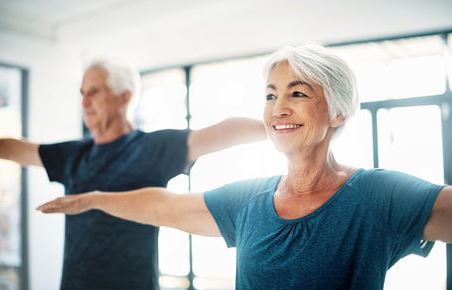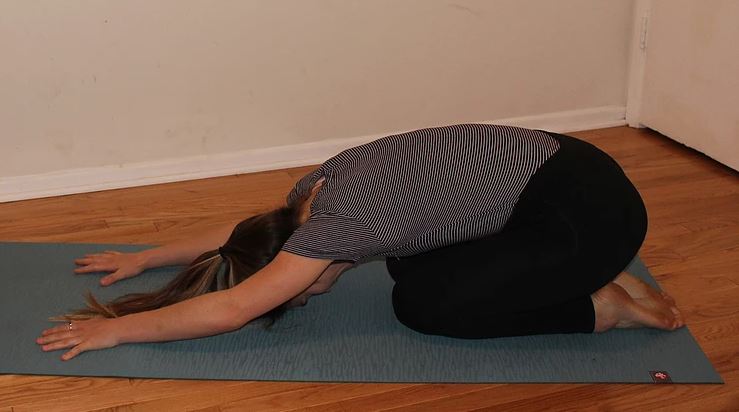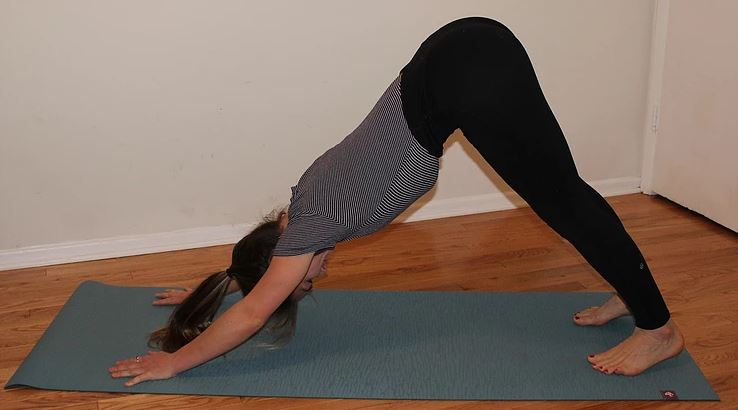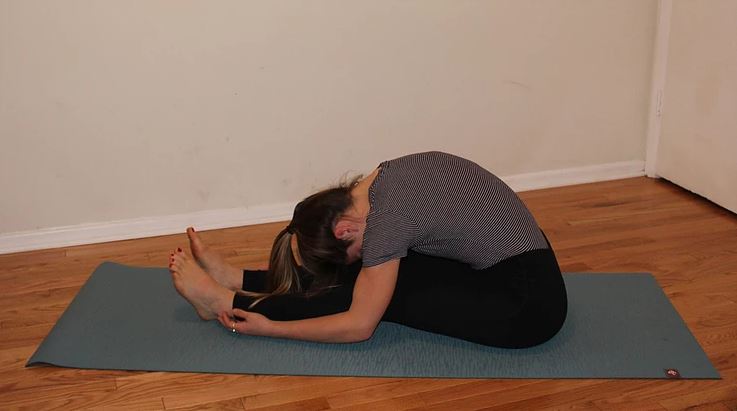Yoga for low back pain has begun to take off as an alternative method to dealing with the issue that many of us deal with. Yoga offers many positions aimed to relieve low back pain as well as strengthen the muscles in the core and back to prevent further injury. Unfortunately for those of us not as flexible as others, the idea of yoga for pain relief can spark fear that it may bring more pain. Fear not, whether you’re preparing for attending a class or planning on adding yoga to your daily practice we’ll outline some simple yoga poses and their modifications.
1. Child’s Pose
Easily the simplest of yoga poses and most commonly known as a “resting position” in between poses, it has it’s own benefits and different modifications. Child’s pose aims to massage the stomach or front of the body while mildly stretching the back muscles. Although this position is known to relieve and stretch the back muscles, it is also known to relax and center an anxious mind. Incorporate some deep inhales (through the nose) and exhales (through the mouth) to sink deeper into this pose. Staying there for as long as tolerated breathe into the posture and focus on your breath.
In addition to a passive stretch to the low back, child’s pose is also known to aide in digestion. The position of your thighs resting against your stomach acts as a massage of the internal organs which can help stimulate your digestion system. This pose may even be beneficial if you have gas, assisting to move your digest system right along.
Modification: spread legs wide if this position bothers your knees or your stomach. Note that this will place more of a stretch on the hips as opposed to the back. If the modification is needed attempt to alternate back and forth between child’s pose and the modification, also known as “wild child” after a few breaths in each position.
2. Cat/Cow
Cat
Push through your shoulders, round your back, and exhale into cat pose. Drop your neck between your arms.
Cow
Relax your spine, dropping your belly low, and look up if it isn’t too much of a stretch. Push the tailbone up and the shoulders back.
Both cat and cow posture aim to relieve stress and increase flexibility in the shoulders, neck, and spine by performing alternating movements of extension and flexion of the spine. Cat posture, held at the top can offer relief to back pain and tension. Hold in a tight, rounded position for a long exhale before returning into the inhale of the cow posture.
Modification: This pose can also be completed in a chair following the same directions but simply placing your hands on your knees.
3. Down Dog
*Note that down dog is technically what is known as an inversion (being upside down). As with any inversion, one must be very cautious if you have any blood pressure issues.
A main benefit of downward facing dog is the reduction of back pain through the strengthening of the spine. The pose promotes lengthening of the back and offers a release in tension of the spine. Although down dog is an inversion, it is a mild inversion and can be known to increase blood flow to the brain.
More than 3 million Americans suffer from what is known as kyphosis, or a forward rounding of the back. Specifically within the age group of 55+. Attempting a downward with strong extended shoulders one can attempt to reverse the affects of a kyphotic posture. Similarly a strong down dog posture can engage the core muscles in turn strengthening the back.
Modification: Bend your knees.
4. Forward Fold (Standing and Seated)
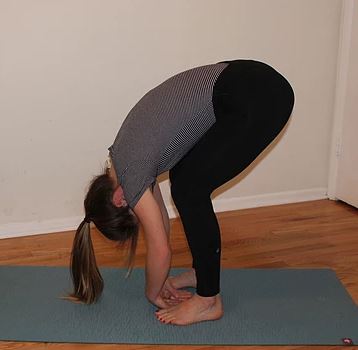 Both the seated and standing forward fold can offer benefits for the entire neck to tail bone. Seated posture can be performed to each individuals abilities, alternating between active stretching and relaxing throughout.
Both the seated and standing forward fold can offer benefits for the entire neck to tail bone. Seated posture can be performed to each individuals abilities, alternating between active stretching and relaxing throughout.
Standing forward fold is also an inversion like down dog and can cause dizziness due to the head being below your heart, so perform with caution. If you have issues with blood pressure considering attempting seated forward fold. Being able to drop your arms low and stretch forward releases tension in the back and increases circulation through the inversion.
Modification: Bend your knees in either the standing or seated to decrease the amount of stretch.
5. Sphinx Pose
The sphinx pose is a gentle, beginner back bend aimed to stretch the abdominal muscles while also opening the chest and back. For most of us who sit all day whether at a desk or on the couch we sit with our back rounded and forward. Getting into a position that opposes this flexed position we can attempt to lengthen the spine and reduce low back pain.
In addition to stretching the back, sphinx pose is also a great chest opener. Chest openers can reverse muscle stiffness in the back and chest and can even attempt to reverse kyphosis (rounded shoulders and spine). Chest openers, as the name implies also have great chest cavity benefits including lung expansion and reduction of shallow breathing.
***Pair this pose with child’s pose for an alternation of positions to relax and balance the core and trunk.
Modification: Perform this posture against a wall for an even more passive stretch.
6. Happy Baby
Although typically performed by grabbing on to the toes and stretching this modification can be used to place the hips into neutral alignment while gently massaging the spine. From this position you can allow for some movement of the hips, knees in order to massage the spine even more. Holding the position also stretches the hips with similar benefits as “wild child” but with increased focus on the spine due to the natural position of this pose.
Modification: Hold on to wherever is comfortable.
7. Pigeon Pose (Reclined)
Pigeon pose is known for it’s many benefits for the hips, but what you may not know is that pigeon pose can also be used to reduce sciatic pain. Sciatic pain or pain that originated in the low back and radiates down the sciatic nerve often occurs with a herniated disc or stenosis which compresses the spine. A traditional pigeon pose is done sitting or leaning forward with one leg forward and one leg back but for this article we will focus on reclined pigeon pose.
So how exactly does pigeon pose help your back? Well first this position opens the hips. And by opening the hips you are also reducing back pain by bringing the pelvis into neutral. Make sure to alternate sides when doing pigeon pose as to maintain symmetry. Stretches to the pelvis and hips increase flexibility in the low back reducing pain and increasing mobility.
Modification: Relax/bend bottom leg to reduce stretch.
8. Bridge
Similar to sphinx in that bridge pose is also a heart opener, a bridge done correctly focuses on strengthening and stretching the entire core. Bridge pose is also known for it’s many benefits to the chest cavity, such as increasing lung capacity and reducing risk for illness due to improved breathing.
Bridge pose can be a challenge for some, be sure to squeeze entire core in order to see the most benefits. Both a strengthening and stretching pose, hold for as long as tolerated but be sure to breathe deeply into this pose as the most benefits will be seen when relaxed vs tense.
Modification: Add a block or a rolled blanket underneath your tailbone to assist with the lift it becomes too challenging.
As with any exercise or stretch the key is comfort and control never engage into a position or posture that is irritating or painful. Similarly avoid over stretching by beginning with a short period spent in a posture and working your way up to a minute or two over the course of a week or two. Never rush or attempt a position that you feel uncomfortable with. If done slowly and without over doing it, yoga can bring benefits of decreased pain and increased flexibility.

